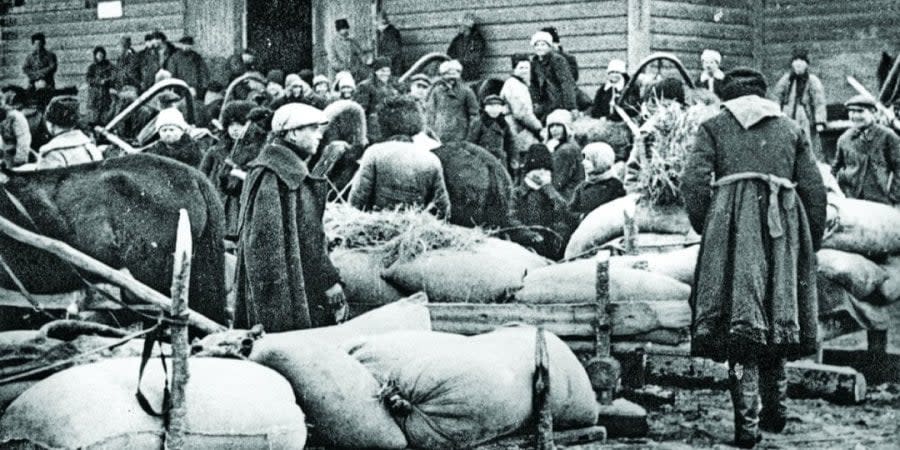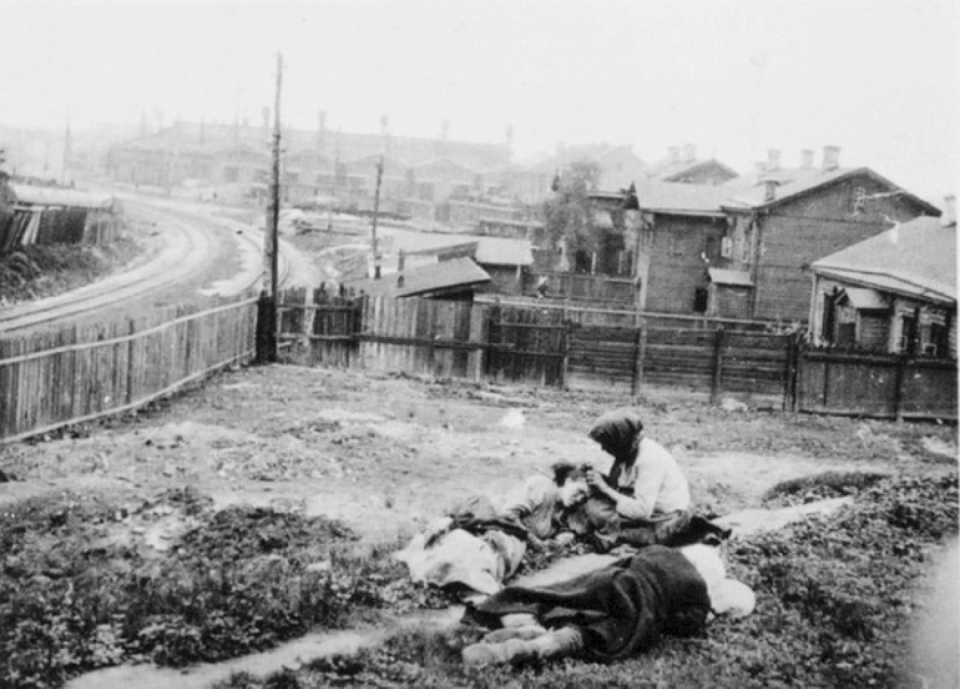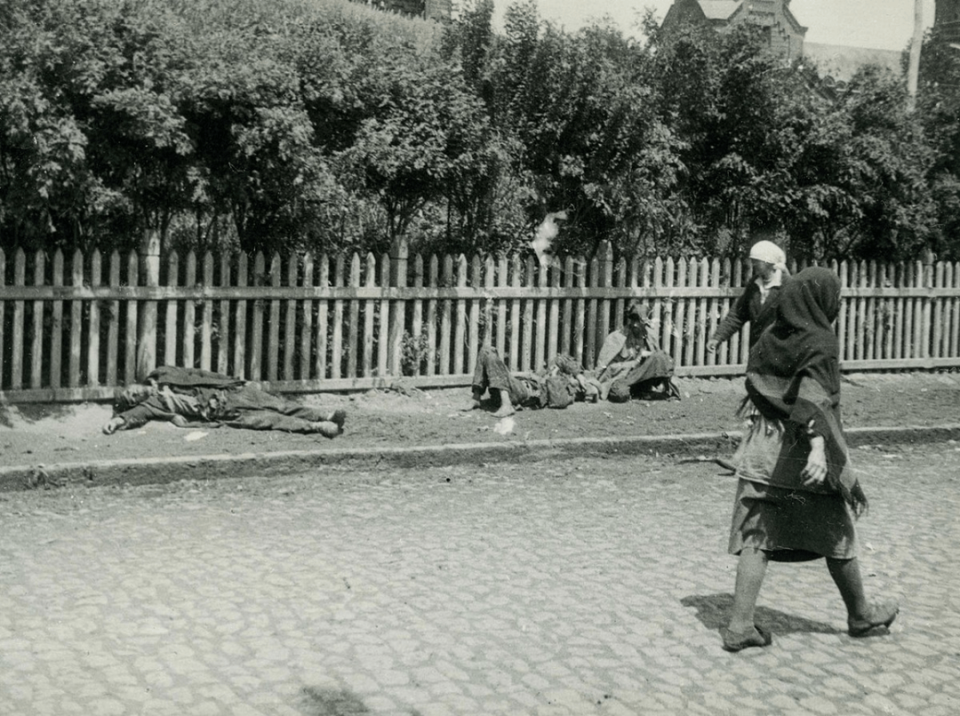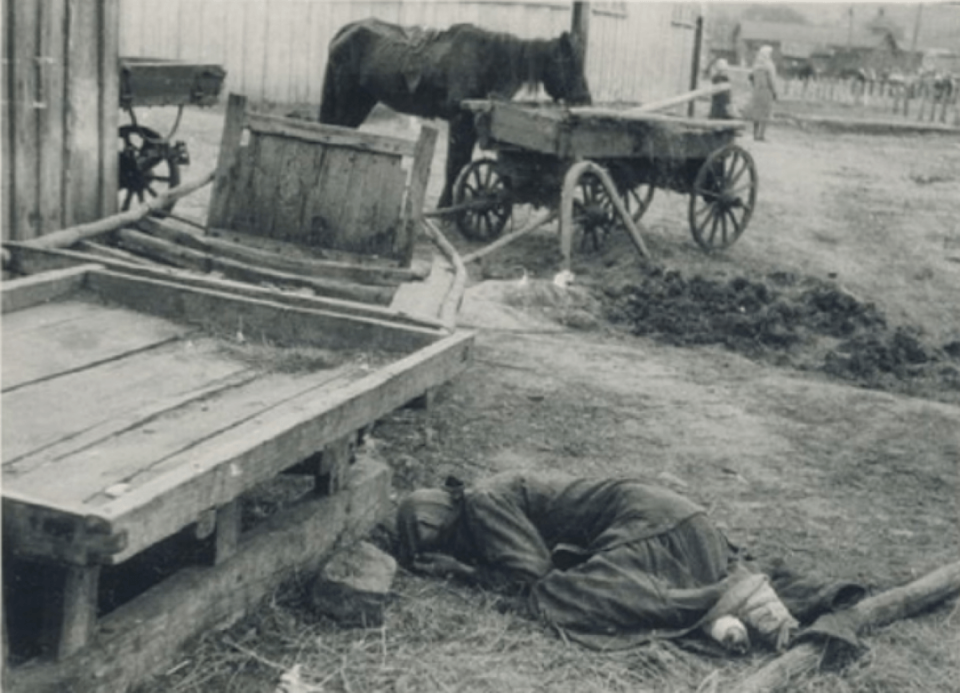Seven figures that reveal the scale of the genocidal Holodomor

- Oops!Something went wrong.Please try again later.
The policy of violent collectivization, which the Stalin regime launched in the USSR at the end of the 1920s and made more brutal in the early 1930s, deepened in Ukraine with targeted repression against the country’s residents. Millions of Ukrainians died during the Great Famine, and even more were never born.
In several significant figures, NV recalls of how the events of the Holodomor of 1932-1933 unfolded.
THE USSR INCREASED GRAIN EXPORTS AT THE EXPENSE OF UKRAINE FOUR TIMES IN TWO YEARS
Bread procurement plans in the USSR in 1930 had doubled compared to 1928. Since the 1920s, this main tool of collectivization caused enormous damage to the agriculture of Ukraine, but by the beginning of the 1930s, the situation had become critical.
At that time, Joseph Stalin considered the export of grain from the country to be almost the main engine of the Soviet economy, and the funds received were the key to successful industrialization. “It is necessary to frantically force the export of bread,” Stalin wrote in a letter to Vyacheslav Molotov in August 1930.
The USSR exported 1.3 million tons of grain in 1929, then in 1930 this number had risen to 4.8 million, and in 1931 it already reached 5.2 million tons. The Soviets never saw such figures again: those were the maximum indicators of grain exports until the Second World War.
Ukraine paid the most expensive price for these records, because in those years up to 70% of exported Soviet grain was accounted for by the Ukrainian SSR and the Kuban (another region inhabited by ethnic Ukrainians).

Meanwhile, the authorities launched a real war in Ukrainian villages for the “dispossession” and ruin of the most successful farms. In the summer of 1930, the General Secretary of the Ukrainian SSR Communist Party Stanislav Kosior said that the peasants allegedly refused to harvest and wanted to “rot the grain in order to strangle the Soviet government with the bony hand of hunger.”
“But the enemy miscalculated,” Kosior said at the party congress.
“We will show them what hunger is. Your task is to put an end to the Kurkul sabotage of the harvest. You must collect it down to the last grain and immediately send it to the procurement plant. Peasants do not work. They rely on pre-harvested grain, which they have hidden in pits. We have to make them open their pits.”
For the residents of Ukrainian villages, such a policy, together with unsustainable plans for grain procurement, was tantamount to murder. In the winter of 1931-1932, famine already caused the death of at least 150,000 Ukrainians. In the summer of 1932, the Politburo of the Central Committee of the Communist Party of Ukraine recorded the complete absence of flour reserves in Ukraine.

At that time, hundreds of regions in the Ukrainian SSR refused to comply with the norms of grain procurement: village councils and collective farms (a.k.a kolkhoz) tried to convince officials that they were unrealistic. The Kremlin considered such a position to be sabotage and a causeless riot on the part of Ukraine.
MORE THAN 50 THOUSAND PERSONS WERE CONVICTED UNDER THE “FIVE EARS OF GRAIN LAW” DURING THE FIRST MONTHS OF ITS EFFECT
On August 7, 1932, the most famous regulatory act was adopted, which turned the brewing disaster into a catastrophe, later recognized as the genocide of Ukrainians.
On this day, the Soviet People's Committee of the USSR issued a resolution “On the Safekeeping Property of state enterprises, collective farms and cooperatives and strengthening of State Enterprises, Collective Farms and Cooperatives and Strengthening Public (Socialist) Property”, which went down in history as the “law of five ears of grain.” – according to which, theft of collective farm property was punishable by firing squad, and only under “extenuating circumstances” could a 10-year term of imprisonment be given for such a “crime.”
Practically, this meant that Ukrainian peasants completely lost access to their own crops and the ability to feed themselves and their families.

At the beginning of 1933, less than half a year after the adoption of the resolution, 54,600 people were sentenced in the Ukrainian SSR under the “law of five ears of grain,” more than 2,000 of them were sentenced to death.
Meanwhile, in August 1932, when the repressive law was approved, in Stalin’s letter to Lazar Kaganovich, he stressed that special attention should be paid to the Ukrainian SSR.
“The most important thing now is Ukraine,” Stalin wrote, as quoted by historian Anne Applebaum in her book, The Red Famine. Stalin's war against Ukraine.
“Things are really bad in Ukraine. (…) If we don’t start right now to correct the situation in Ukraine, we may lose Ukraine. (…) Keep in mind that in the Ukrainian Communist Party (…) there are a lot of rotten elements, conscious and unconscious Petlyura followers, and finally, direct agents of Pilsudsky.”
UP TO 80% OF SETTLEMENTS AND KOLKHOZ COLLECTIVE FARMS OF THE USSR, OBLIGED TO IMPLEMENT GRAIN PLANS, ENDED UP ON “BLACK BOARDS”
The regime of “black boards” became one of the main and most terrifying tools of the Holodomor of the 1930s. For “malicious sabotage of grain procurement” — and in fact, the impossibility of carrying out these ambitious plans — entire districts, settlements, collective farms, village councils were put on the so-called “black boards.”

Such a decision of the regional and district committees of the Communist Party of Ukraine meant that local residents lost the right to travel outside their settlement, and all their food was confiscated. Special forces and troops blockaded villages, seized all food, prohibited any form of trade and effectively left people with no chance to survive or seek salvation in the cities.
According to the Ukrainian Institute of National Memory and Ukrainian publication Istorychna Pravda, these repressive measures came to their peak around November-December 1932, when more than 80% of all settlements, kolkhozes, rural councils, and districts, where the amounts of grain procurement was assessed, were on “black boards.”
In addition to the Ukrainian SSR, this regime also operated in several other territories of the USSR inhabited by Ukrainians (Volga, Kuban, Don, Seriy Klyn in Kazakhstan).
“In the village of Klenotoch, people were dying, as everywhere else in Ukraine – their bread and all food was taken away, and they were left to their inevitable death; because the state, as a mortal enemy, using force against them, in addition to food, also took away the opportunity to earn a living. The situation is worse than during the plague,” Ukrainian writer Vasyl Barka described the realities of those years in his novel about the Holodomor, The Yellow Prince.
15 MONTHS WITHOUT MEAT WAS THE INITIAL AMOUNT OF THE “NATURAL PENALTY” FOR BREAKING THE PLAN
Every few months in 1932, the punitive measures that provoked the Holodomor intensified. On 18 November 1932, the Central Committee of the Ukrainian Communist Party issued a resolution “On Measures to Strengthen Grain Procurement”, according to which individual farms were punished for non-fulfillment of plans with so-called “natural fines”, the least of whose was confiscation of 15 months’ worth of meat.
Two days later, the People’s Committee of the Ukrainian SSR allowed the application of these natural fines to collective farms as well. Soon, the list of products that were withdrawn as “compensation” for grain was expanded to include potatoes and lard, and by the end of 1932, most other products.

In the book Famine of 1932-1933 in Ukraine: through the eyes of historians, in the language of documents, published in 1990, it is stated that at that time similar “natural fines” were applied to the absolute majority of kolkhozes in Ukraine (no more than 6.4% of kolkhozes escaped them).
Meanwhile, the Politburo of the Central Committee of the Ukrainian Communist Party in November 1932 ordered to launch a large-scale campaign in Ukraine against “ideologists and organizers of Kurkul sabotage,” to carry out purges among accountants and bookkeepers, and to deal a “decisive blow to Kurkul elements.”
PEOPLE WHO PRESERVED THE MEMORY OF THE HOLODOMOR FOR HISTORY RECEIVED 10 YEARS IN CAMPS
Among them was Oleksandra Radchenko, a teacher from Kharkiv Oblast, whose fate was previously reported by Istorychna Pravda. As a public servant, she was entitled to food rations and was able to save her family, but she kept a diary about the horrors of the Holodomor that she saw around her.

Here are some of her entries:
“April 5, 1932, Tuesday. Famine, artificially created hunger, takes on a terrible character. Why they take away the last grain of bread – no one understands, and now, when they already see the result of such expropriation, they still continue to demand bread for sowing... And the children are starving, tortured, thin, disfigured by worms, because they only eat beets, which are also about to end, and the harvest is still four months away. What will happen?”
“January 9, 1933, Monday. The horrors of hunger are happening in Kharkiv. They steal children and sell sausage made of human meat. Bringing adult people (fatter) under the pretext of selling shoes. Even the newspapers wrote about it, reassuring that measures are being taken, but... children keep disappearing.”
“March 23, 1933, Thursday. I saw a lot of human misery that day. I returned home with heavy impressions. (…)
Leaving Babka (a village near Kharkiv), we caught up with a seven-year-old boy. My companion shouted, but the boy kept walking, swaying, and didn’t seem to hear. The horse caught up with him, I shouted, the boy reluctantly turned off the road and I was drawn to look at his face. And the expression of this face left a terrible, terrible, unforgettable impression.
People probably have this look in their eyes when they know they are about to die and don’t want to die. But it was a child! My nerves couldn’t stand it: “For what? Why children?” I cried quietly so that my companion would not see. The thought that I couldn't do anything, that millions of children were dying of hunger, that it was all the elements, drove me to despair. (…)
A few days ago, the groom came – his face was already swollen, his hands were swollen. He says that his legs are heavy, he calmly prepared to die. “I feel sorry for the children,” he says. “They do not understand anything – they are innocent.”

Oleksandra Radchenko’s family survived the Holodomor and changed several places of residence in Ukraine. However, in July 1945, already after the end of the Second World War in Europe, NKVD investigators arrested Radchenko.
During the search of her apartment, they found seven notebooks with diaries for the years of 1926-1943. Based on them, the woman was accused of “anti-Soviet propaganda and agitation.” The indictment stated that Oleksandra Radchenko, “being hostile to the Soviet government in the period of 1930-1933, wrote a diary of counter-revolutionary content, in which she condemned the actions of the Communist Party of the organization of kolkhozes in the USSR and described the difficult financial situation of the working people.”
For this, Radchenko was sentenced to 10 years in Gulag camps and served the full term of imprisonment, returning to Ukraine only in the summer of 1955. In court, she unsuccessfully tried to prove that she kept her records for future generations.
“I wrote that in 20 years, children will not believe that socialism was built with such brutal methods,” explained Radchenko.
6 MILLION PEOPLE WERE NOT BORN IN UKRAINE DUE TO THE HOLODOMOR
Ukraine’s demographic losses, as well as the number of direct victims of the Holodomor, remain the subject of historical discussions and research — but there is no doubt that these numbers run into millions.
In 2010, the Court of Appeal of Kyiv, having studied the materials of the criminal case on the fact of genocide in Ukraine in 1932-1933, came to the conclusion that the Holodomor took the lives of 3.9 million people, due to which another 6.1 million people were not born in our country (due to so-called fertility deficiency).

Western historian Timothy Snyder believes that the number of victims was at least 3 million people, and in 2016 at the international conference Holodomor 1932−1933: Losses of the Ukrainian Nation, which was held at Taras Shevchenko Kyiv National University, estimates of 7 million victims of the Holodomor in the Ukrainian SSR and 10 million in the entire USSR were brought up.
In the spring and summer of 1933, mortality from hunger in Ukraine reached the most catastrophic proportions. According to the National Holodomor Genocide Museum, by June 1933, approximately 28,000 people perished in Ukraine from hunger: 1,168 every hour, 20 every minute.
ZERO PEOPLE WERE PUNISHED FOR THE HOLODOMOR IN SOVIET UKRAINE
Before the collapse of the USSR, the causes of the Holodomor were never investigated, the topic of this tragedy remained banned for decades, and none of the officials were punished for organizing the artificial famine in Ukraine.
Only in December 1987, the first secretary of the Central Committee of the Communist Party of Ukraine, Volodymyr Shcherbytskyy, in a report dedicated to the 70th anniversary of the formation of the Ukrainian SSR, mentioned the fact of mass hunger in the 1930s.
In 2009, the main investigative department of the SBU Security Service initiated a case under Part 1 of Art. 442 of the Criminal Code of Ukraine – in connection with the commission of genocide by officials in Ukraine in 1932-1933, as a result of which millions of citizens died.

In January 2010, the Kyiv Court of Appeal issued its opinion in this case, confirming the conclusions of the SBU investigators about the organization of “genocide of the Ukrainian national group - that is, the artificial creation of living conditions calculated for its partial physical destruction” on the territory of the Ukrainian SSR during that period. The court concluded that the leaders of the Bolshevik totalitarian regime — Joseph Stalin, Vyacheslav Molotov, Lazar Kaganovich, Pavel Postyshev, Stanislav Kosior, Vlas Chubar, and Mendel Hatayevich — were responsible for organizing the Holodomor.
They were not charged, as the case was closed due to the death of the mentioned persons. However, according to the head of the SBU at the time, Valentyn Nalyvaichenko, the process had important historical significance for Ukraine. He reminded that genocide is a crime against humanity, which, according to the UN Convention of Nov. 26, 1968, has no statute of limitations.
“Thus, by the decision of the competent court, our country has fulfilled its international obligations — to take measures to prevent genocide and punish its commission,” Nalyvaichenko said.
Based on the materials of the Ukrainian Institute of National Memory, Istorychna Pravda portal, the book Red famine: Stalin’s war on Ukraine by Anne Applebaum, the National Museum of the Holodomor-Genocide
Read the original article on The New Voice of Ukraine

